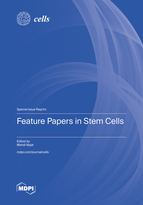Feature Papers in Stem Cells
A special issue of Cells (ISSN 2073-4409). This special issue belongs to the section "Stem Cells".
Deadline for manuscript submissions: closed (15 April 2022) | Viewed by 88460
Special Issue Editor
Interests: mesenchymal stem/stromal cells (MSCs); tissue sources of MSCs; immunomodulation properties; extracellular vesicles (EVs); environmental challenges; efficient MSC immunotherapy
Special Issues, Collections and Topics in MDPI journals
Special Issue Information
Dear Colleagues,
Embryonic and induced pluripotent stem cells (ESCs and iPSCs) as well as adult stem cells hold great promise for future cell replacement therapies, all having advantages and concerns. Their developments require in-depth knowledge to understand and control the mechanisms of the maintenance of and exit from the undifferentiated state in specific biomaterials mimicking native niches. When grown in 3D, ESCs or iPSCs can recapitulate embryonic development as blastoids or organoids do and they are ideal for drug screenings and genetic disease modeling. Although cells of the inner cell mass are in a transient state in the embryo and last just for a few days, it has been possible to capture their pluripotent fate in vitro. Indeed, they can be grown as cell lines indefinitely thanks to deep insights in the fundamental knowledge of their physiology. It is a paradox with adult stem cells which last throughout our entire life in specific physioxic niches in our body, but which are still difficult to cultivate as cell lines in vitro for more than 30 passages. In this Special issue of Cells, we will gather articles and reviews on recent fundamental and applied advances on ESC, iPSCs, and mesenchymal stem cells.
Dr. Mehdi Najar
Guest Editor
Manuscript Submission Information
Manuscripts should be submitted online at www.mdpi.com by registering and logging in to this website. Once you are registered, click here to go to the submission form. Manuscripts can be submitted until the deadline. All submissions that pass pre-check are peer-reviewed. Accepted papers will be published continuously in the journal (as soon as accepted) and will be listed together on the special issue website. Research articles, review articles as well as short communications are invited. For planned papers, a title and short abstract (about 100 words) can be sent to the Editorial Office for announcement on this website.
Submitted manuscripts should not have been published previously, nor be under consideration for publication elsewhere (except conference proceedings papers). All manuscripts are thoroughly refereed through a single-blind peer-review process. A guide for authors and other relevant information for submission of manuscripts is available on the Instructions for Authors page. Cells is an international peer-reviewed open access semimonthly journal published by MDPI.
Please visit the Instructions for Authors page before submitting a manuscript. The Article Processing Charge (APC) for publication in this open access journal is 2700 CHF (Swiss Francs). Submitted papers should be well formatted and use good English. Authors may use MDPI's English editing service prior to publication or during author revisions.
Keywords
- embryonic stem cells (ESCs)
- induced pluripotent stem cells (iPSCs)
- mesenchymal stem cells (MSCs)
- stem cells from apical papilla (SCAP)
- leukemia inhibitory factor (LIF)
- pluripotency
- hypoxia/physioxia
- autophagy
- differentiation
- regenerative medicine
- 3D blastoids/organoids







